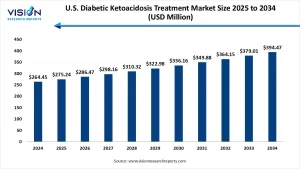The U.S. diabetic ketoacidosis treatment market size was valued at around USD 264.45 million in 2024 and it is projected to hit around USD 394.47 million by 2034, growing at a CAGR of 4.08% from 2025 to 2034.
Get a Sample@https://www.visionresearchreports.com/report/sample/41760
U.S. diabetic ketoacidosis treatment Market Overview
The U.S. diabetic ketoacidosis (DKA) treatment market is gaining attention due to the rising incidence of diabetes and its acute complications. Diabetic ketoacidosis is a serious, life-threatening condition that occurs when the body starts breaking down fat too quickly, leading to high levels of ketones in the blood. It requires prompt medical intervention involving fluid replacement, insulin therapy, and electrolyte management.
With increasing awareness and advancements in emergency care and endocrinology, healthcare providers are better equipped to detect and manage DKA in its early stages, contributing to improved treatment outcomes and growing demand for specialized care services.
U.S. diabetic ketoacidosis treatment Market Growth
The market is expanding due to a growing diabetic population, particularly among type 1 diabetics who are more prone to DKA. Emergency hospital visits for diabetic complications are becoming more common, further driving demand for treatment solutions. In addition, technological advancements in insulin delivery systems and continuous glucose monitoring are helping reduce recurrence rates and improve response time, creating a supportive environment for market expansion.
Healthcare policy improvements and insurance coverage for diabetes-related complications in the U.S. also play a major role in enabling access to DKA treatment. The focus on integrated care models involving endocrinologists, emergency physicians, and critical care specialists is further enhancing the quality of care, thereby boosting market growth.
What is Diabetic Ketoacidosis (DKA)?
Diabetic ketoacidosis (DKA) is a serious and potentially life-threatening complication of diabetes. It happens when the body doesn’t have enough insulin to allow glucose to enter the cells for energy. Instead, the body starts breaking down fat as fuel, which produces ketones—a type of acid that builds up in the blood. When ketone levels become too high, it causes the blood to become acidic, leading to symptoms like extreme thirst, frequent urination, nausea, abdominal pain, confusion, and in severe cases, coma. DKA requires immediate medical treatment to restore fluid balance, reduce blood sugar levels, and reverse the acidosis.
Who Needs DKA Treatment?
DKA treatment is needed by individuals primarily those with type 1 diabetes—who experience dangerously high ketone levels and blood sugar. It can also occur in people with type 2 diabetes during periods of illness, infection, or missed insulin doses. Children, teens, and young adults with newly diagnosed type 1 diabetes are particularly at risk. Patients showing symptoms like vomiting, rapid breathing, fatigue, and fruity-smelling breath should seek emergency care. Early detection and timely treatment are critical to prevent serious health consequences
U.S. diabetic ketoacidosis treatment Market Dynamics
Drivers
- Rising prevalence of type 1 and type 2 diabetes
- Improved emergency care and diagnostic tools
- Government focus on diabetes management programs
Opportunities
- Technological integration in monitoring and treatment
- Personalized treatment plans based on patient risk profiles
- Development of rapid-acting insulin therapies
Challenges
- High treatment costs and hospital care expenses
- Delayed diagnosis in underinsured populations
- Limited patient awareness in rural or underserved areas
Applications in the Market
- Emergency Rooms: Diabetic ketoacidosis (DKA) treatments are critical in emergency settings where patients often arrive with severe symptoms such as dehydration, altered consciousness, or dangerously high blood glucose levels. Rapid intravenous insulin administration, fluid replacement, and electrolyte balancing are initiated here to stabilize the patient quickly.
- Inpatient Care Units: Once stabilized, patients are often transferred to inpatient units where they receive continuous monitoring, further treatment, and supportive care. This stage includes regular glucose checks, insulin adjustments, and close observation of kidney function and vital signs to ensure recovery.
Case Study: Rapid Recovery via Multidisciplinary Approach
At a major urban hospital in New York, a 15-year-old type 1 diabetic presented with symptoms of DKA. The coordinated efforts of emergency staff, endocrinologists, and nutritionists led to timely administration of fluids, insulin, and education for both the patient and family. The patient recovered within 48 hours and was enrolled in a CGM program. Follow-up showed zero recurrence for 12 months highlighting the impact of integrated care pathways in managing DKA.
U.S. diabetic ketoacidosis treatment Market Trends
- Rise in Continuous Glucose Monitoring (CGM) Adoption: Increased use of CGMs is improving early detection of high glucose and ketone levels, helping prevent full-blown DKA episodes.
- Telemedicine and Digital Health Integration: Telehealth platforms are increasingly used to monitor at-risk diabetic patients, enabling early intervention and reducing emergency visits.
- Advancements in Insulin Delivery Devices: Smart insulin pumps and automated insulin delivery systems are contributing to better glucose control, lowering the risk of DKA.
- Focus on Pediatric and Adolescent Diabetes Care: Special care models are emerging for younger diabetic patients who are highly vulnerable to DKA, enhancing treatment accuracy and patient education.
Read More:https://www.heathcareinsights.com/herbal-supplements-market/
Top Companies in Market
- Novo Nordisk A/S
- Eli Lilly and Company
- Sanofi S.A.
- Pfizer Inc.
- B. Braun Melsungen AG
- Baxter International Inc.
- Abbott Laboratories
- F. Hoffmann-La Roche Ltd.
- Medtronic plc
Dexcom, Inc.
Market Segmentation
By Treatment
- Fluid Replacement Therapy
- Electrolyte Replacement Therapy
- Insulin Therapy
- Others
By End Use
- Hospital
- Ambulatory Surgical Centers (ASCs)
- Homecare Settings
Future Outlook
The future of the U.S. diabetic ketoacidosis treatment market looks promising, driven by improved treatment protocols and preventive strategies. With ongoing innovations in insulin therapy, AI-based monitoring systems, and expanded access to care through telehealth, the market is expected to see continued moderate growth. Preventive care, patient education, and targeted therapies will shape the next decade of DKA management in the U.S.
Buy this Premium Research Report@https://www.visionresearchreports.com/report/checkout/41760
You can place an order or ask any questions, please feel free to contact
sales@visionresearchreports.com| +1 650-460-3308
